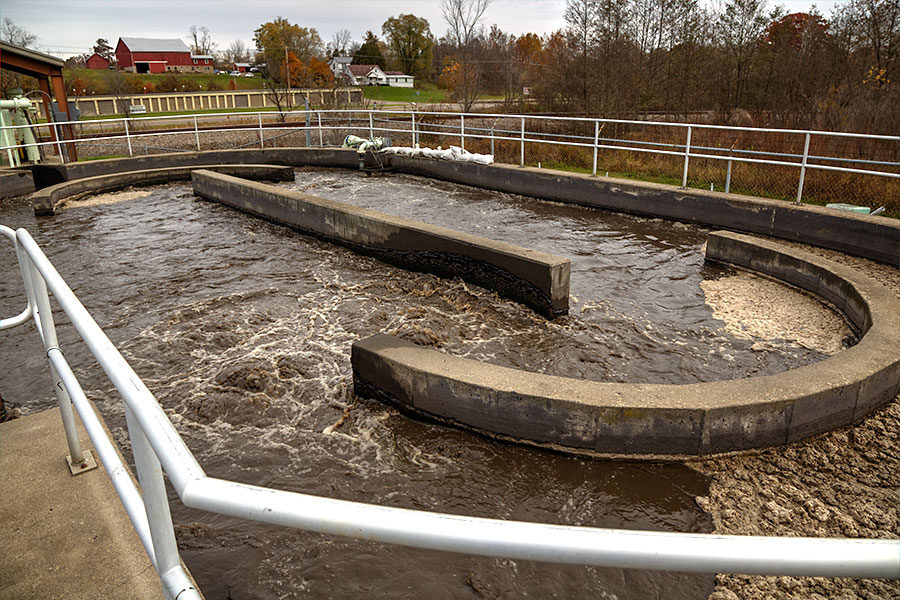Introduction to Wastewater Phosphate Removal Options
Published on by Erik Rumbaugh, Vice President at Aster Bio in Technology
Introduction to phosphorus removal with advanced biological treatment, chemical precipitation, and constructed wetlands.

Many waterways experiencing problems with algae blooms - including toxin producing cyanobacteria. So more wastewater treatment plants have received more stringent nutrient discharge permits.
While nitrogen in the form of ammonia and nitrite have long been regulated, facilities are now being required in many areas to bring effluent phosphate below 1 mg/L.
Effluent phosphorus comes in two main forms, soluble and particulate. The particulate form is bound in the MLSS and can be removed by improving solids separation. Improving solids removal should be the first strategy in meeting effluent phosphorus permits. Often we also have to remove a soluble phosphorus from the effluent which is more difficult.
Biological Phosphorus Removal
In biological phosphorus removal, conditions promoting the growth of phosphorus-accumulating organisms (PAO) must be maintained. The PAOs are facultative anaerobic bacteria that store energy in the form of polyphosphate granules (inside cells).
The stored energy powers uptake of volatile fatty acids (VFA) - usually acetic, propionic, & butyric under anaerobic conditions. The uptake of VFAs ends up releasing phosphate into the surrounding water. Once in an aerobic environment, the PAO organisms use the stored VFAs for energy and uptake the free phosphorus in the water and store it as polyphosphate inside the cells.
PAO organisms do not develop unless their ecological niche exists in the system. So a normal aerobic system will not have an abundance of PAO in the biomass - since conditions exploited by their unique metabolism are not present. What are the required conditions to favor PAO growth:
- Must have a true anaerobic zone - without nitrate/nitrite or dissolved oxygen
- The anaerobic zone must have volatile fatty acids (VFA) that are used by the PAO
- pH must be above 7.0 (GAO organisms start to have an advantage at lower pH - GAO do not uptake phosphorus)
- Temperature best below 30oC - as other organisms start to outcompete the PAO (again the GAO organisms)
- Anaerobic conditions must be followed by oxygen rich (aerobic) conditions
Chemical Phosphorus Removal
Using alum, ferric salts, or even lime for chemical precipitation is the oldest method for reducing soluble phosphorus in effluents. Today we usually use alum or ferric salts since they function better at the near neutral pH seen in wastewater treatment units. Coagulants can be added at any stage in the waste treatment unit to bind with phosphorus.
However, the most common area is to use the coagulants in the secondary or tertiary clarifiers. This avoids removing the phosphorus needed for biological treatment in the biological unit. It also reduces coagulant dosage when compared to dosing at the primary clarifier where other competing materials bind with the coagulants.
The major downside to chemical precipitation is the increased volumes of sludge and metal salts in the sludge.
Constructed Wetlands
Another option for phosphorus removal, that most mimics natural processes, is to construct wetlands that act as a biofilter to remove trace organics, nutrients, and solids before final discharge.
Constructed wetlands should be a first choice option in areas with large amounts of land as they have fewer energy, chemical or labor requirements demanded by either advance biological systems or chemical treatment.
In many cases, the wetlands can be a natural area or park that benefits wildlife and local residents. Most of the phosphorus removal in constructed wetlands is accomplished through plant and uptake of the nutrients.

Oxidation Ditch technology can be used for biological nutrient removal. Photo newconcord-oh.gov
Source: Biological Waste Expert
Media
Taxonomy
- Treatment
- Treatment Methods
- Chemical Treatment
- Waste Water Treatments